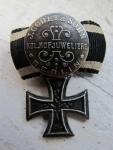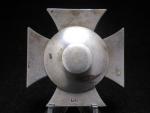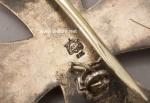-
Posts
282 -
Joined
-
Last visited
Content Type
Profiles
Forums
Blogs
Gallery
Events
Store
Everything posted by Streptile
-

EK 1914 ek fake production great brittan
Streptile replied to hagahr's topic in Germany: All Eras: The Iron Cross
That is how it seems to me also. -

EK 1939 Information required regarding Iron Cross
Streptile replied to Bertie2304's topic in Germany: All Eras: The Iron Cross
Hi Bertie, The cross is 100% fake, with no question or doubt. You can be sure. I'm sorry for the bad news -- it is a well-known modern fake. To verify the oakleaves, you must post good photos of the front and the back, not sideways, and clearly show the marks. Also please post dimensions in .10 mm and weight in grams without ribbon (for oakleaves only -- the cross has no chance to be original). The current world renowned Knight's Cross expert Dietrich Maerz, author of The Knight's Cross of the Iron Cross and Higher Grades (which include the oakleaves) is a member and moderator of Wehrmacht Awards Forum (here). You could try to contact him through that forum, or post your set there. -

EK 1939 Information required regarding Iron Cross
Streptile replied to Bertie2304's topic in Germany: All Eras: The Iron Cross
Hi Bertie, What you have there is a FAKE 1939 Knight's Cross of the Iron Cross. On top is a set of oakleaves and swords. I can't say if these are authentic from your photos, but they do not look promising. Some Iron Crosses can be valuable indeed. Your set (assuming the oaks/swords are fakes, which I guess they are) is worth about $150. But if this set were authentic, you might sell it for $30,000 or more. -

EK 1870 1870 -EK2 big miniature or kind of Prinzen Type ?
Streptile replied to Graf's topic in Germany: All Eras: The Iron Cross
-

EK 1870 1870 -EK2 big miniature or kind of Prinzen Type ?
Streptile replied to Graf's topic in Germany: All Eras: The Iron Cross
-

EK 1870 1870 -EK2 big miniature or kind of Prinzen Type ?
Streptile replied to Graf's topic in Germany: All Eras: The Iron Cross
Nice little piece! J. Godet made two types of small 1870 EK2 that I know -- one like yours (a typical Godet button piece) and also one slightly larger in three pieces, silver frames and magnetic core. Graf, I would say yours could be a pendant for a lapel chain, or possibly a piece of patriotica. -
I'd say you're roughly right -- 1:1000 (straight-9 to Round 3). They are very rare, but they do pop up for sale every now and again.
-

EK 1914 1914 EK1 with screwback marked L/12
Streptile replied to Graf's topic in Germany: All Eras: The Iron Cross
This cross does not use AWS's frame, but Juncker's own frame. It has the later-war thin screwpost, which AWS never used. I would say it's probably from around 1942 or 43 judging by the components. -

EK 1914 1914 EK1 with screwback marked L/12
Streptile replied to Graf's topic in Germany: All Eras: The Iron Cross
Hi Graf, Your L/12 EK1 is an authentic C.E. Juncker EK1 from after 1941, however else you want to classify it. In fact, I used to own that cross (before it was cleaned) til I upgraded with one from Sascha's shop in better condition. The discussion of the terms (original, copy, fake) has been happening for a long time (and usually with Uwe). Most English-language collectors use "copy" and "fake" interchangeably, but the precise definitions do have real meaning and importance, so hopefully this will change in the future. -

EK 1939 DOUBT ABOUT TWO EK I CLASP
Streptile replied to PAUSANIAS's topic in Germany: All Eras: The Iron Cross
No, not accurate. Johannes Floch is a private individual, still alive and well, who bought fake (postwar-made) German medals in his native Germany and resold them as souvenirs in America as a teen in the 1960s. He never made any fakes of any sort, and his name was never the name of a maker, before or after the war. He has simply had the misfortune of having his personal name associated with some good fakes. No one in the collecting community knows to this day who actually made the fakes he sold in the 1960s. Many are marked L/21, 15 or L/15, but none of these makers made "Floch fakes." -

EK All Eras Your Iron Cross Bookshelf......
Streptile replied to Chris Boonzaier's topic in Germany: All Eras: The Iron Cross
Hi Chris, I didn't mean to really put the boot in so far... but all of the errors I mentioned are in the book, and a lot more. From what I know about Geißler, he is entirely offline, so I don't know that he would have access to a lot of the information that's come out in recent years. To me, in the final analysis, Geißler's new book is like The Iron Time (1st ed.) in German -- a nice hardcover book with some photos of some very nice items and some breathtaking errors. It's not a scientific book, but it's a good picture book. Personally, I would not be without it. Maybe we should get a real catalogue of errors in Geißler here. I think as far as Iron Cross books go, Maerz & Stimson's The Iron Cross 1. Class of 1939 book is by far the one with the fewest errors. There are one or two small ones, which for a book of that scope is really very impressive in my opinion. To me the one problem, which was the result of an abundance of caution rather than oversight, is the omission of interesting variants. This could be rectified in future editions if the authors so choose. -

EK 1914 The KO stamped EKs
Streptile replied to Chris Boonzaier's topic in Germany: All Eras: The Iron Cross
Ha ha! That's a good one I never considered. I agree that K&Q is a stretch, but it's one of the theories out there. -

EK All Eras Your Iron Cross Bookshelf......
Streptile replied to Chris Boonzaier's topic in Germany: All Eras: The Iron Cross
I think Geißler's book is extrememly mediocre... just "ok". There are a ton of errors, fakes, and flaws in almost every section. A "ninth-bead" 1870 EK1? Come on. He seems to have assigned makers to 1939 EK2s for no special reason, and he calls frames a match when they share one single characteristic (L/54 and Deschler frames are not the same, ha ha!) Fake 1813 EK1s, fake oakleaves, etc. Unknown Maker Schinkel by Juncker? Hardly. The list goes on. I like it for a few nice items shown in photos, and because I am an Iron Cross book completist. But in a few years I don't think anyone will rate this book at all, unfortunately for Geißler. -

EK 1914 The KO stamped EKs
Streptile replied to Chris Boonzaier's topic in Germany: All Eras: The Iron Cross
I've never personally seen a KO cross (that I believed in or did not have a replaced ring) with anything other than their traditional and very distinctive frame. I think they used only one frame, but I'd be happy to see something new. They used various cores, for sure. Their frame is ntoable for having the smallest arm width (measured on the outside) of any maker, giving them the appearance of a very small cross. I agree that KO is not Konigliches Münzamt Orden Berlin. I don't think too many people believe this old theory anymore. I have read interesting theories for: Paul Küst Orden, Berlin and Klein u. Quenzer Oberstein ...but nothing to convince me beyond the shadow of a doubt yet. I think KO remains an unknown maker and I also believe them to be from the 2nd half of the war, absolutely. -

EK 1914 Lets see your KOs
Streptile replied to Chris Boonzaier's topic in Germany: All Eras: The Iron Cross
Greg's EK1 shows the most common KO core. Chris, the one you show in post 2 has a "CD" core and is quite uncommon (though not unknown obviously) in KOs. -

EK 1914 A Rare EK1 with a latch lock of the pin by AWS
Streptile replied to Graf's topic in Germany: All Eras: The Iron Cross
Congratulations on everything working out. Very nice Juncker screwback. Funny how this hobby works -- I used to own that cross. -

EK All Eras Your Iron Cross Bookshelf......
Streptile replied to Chris Boonzaier's topic in Germany: All Eras: The Iron Cross
I don't know, I think Bowen is well known among EK collectors. He has put out a few different versions of his great book: hardcover in slipcase, paperback, and even an expanded edition with photocopies of all the original documents, plus translations of them, that he was able to find on his travels. He hit the pavement for real -- no internet surfing for him. He traveled around to archives and museums, met with vets and collectors, and put together a really superb piece of research. His expanded book is the EK Bible for anyone interested in 1813-1957. I have seen precisely one copy of it in my lifetime. -
The last one I saw sell went for €900. It certainly is among the rarest of EK2 variants -- far rarer than the Ubergroße, which sells for €600, and rarer even that the B-Type, which goes for €900 as well.
-

EK All Eras Your Iron Cross Bookshelf......
Streptile replied to Chris Boonzaier's topic in Germany: All Eras: The Iron Cross
I agree Bowen is absolutely superb! -

EK All Eras Your Iron Cross Bookshelf......
Streptile replied to Chris Boonzaier's topic in Germany: All Eras: The Iron Cross
I think this is a decent book. There is a lot of eye candy, and some rare variants. It is like a German "Iron Time." There are also some quite glaring mistakes. I would be happy to post some photos of the pages if anyone has any specific requests. -
Rare indeed! The so-caled "Straight-9" Schinkel. Just recently on another forum, a similarly rare 1914-core EK was posted which uses this same frame.
-

EK 1870 Third Reich 1870 EK1
Streptile replied to Obergefreiter's topic in Germany: All Eras: The Iron Cross
This piece is a fake made within the past few years. It can be found with cores from 1870 to 1939, and a wide variety of different hardware. A very good "tell" for this fake is the highly distinctive frame -- both the shape, which is unlike any period cross from any maker save perhaps Meybauer. The hardware resembles some period original Anti-Partisan Badges, but is not an exact duplicate of that style, and the cores (from whichever period) are always wrong, although the Schinkel core is a reasonable facsimilie of the Deumer type. I have photos of this fake in all its incarnations which I can post. -

EK 1914 A Rare EK1 with a latch lock of the pin by AWS
Streptile replied to Graf's topic in Germany: All Eras: The Iron Cross
Hi there, In my opinion this EK is probably marked "925" as AWS EKs are unknown (to me) marked "935," the pin is definitely replaced, and the locking mechanism has been added -- perhaps by a jeweler at the request of the original wearer to better secure the cross on his tunic. To explain further: AWS pins were bent silver wire. The bend at the hinge end provided the lift, or tension, for the pin which kept it snugly seated in the catch. So this pin was replaced, but a new mechanism was needed to keep the pin seated, since the original AWS pin design was no longer present. Hence the added plate and crossed wires. I find it an interesting example of a highly personalized -- indeed unique -- private purchase (duplicate) EK1 that we can be almost certain was actually worn. As a side note, EK1s with that AWS stamp are very, very uncommon. A raised version is common on the pillowback examples, but the actual stamped version is not often seen. Congratulations on a fine EK1. I remember when it was offered for sale recently and did save the photos. -
Thanks Don. A very helpful link,







